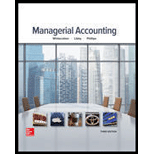
Concept explainers
Concept introduction:
Traditional costing systems use predetermined
Predetermined Overhead allocation rate:
The Predetermined Overhead allocation rate is used to allocate the manufacturing overhead over the jobs. Predetermined Overhead allocation rate is calculated by dividing the Total Estimated overhead cost by the Total Estimated allocation base.
The formula to calculate the Predetermined Overhead allocation rate is as follows:
To choose:
The Correct option which is volume based allocation measure
Want to see the full answer?
Check out a sample textbook solution
Chapter 4 Solutions
Managerial Accounting
- true (T) or false (F) The cost per equivalent unit is computed as the total costs of a process divided by the number of equivalent units passing through that process.arrow_forwardcompute Actual number of machine-hours used per output unitarrow_forwardWhich of the following is a batch-related cost driver?a. number of machine hoursb. number of setupsc. number of engineering changesd. number of direct labor hourarrow_forward
- The equivalent units for the FIFO unit cost represent: a. work done during the current period. b. work done during the current period and the previous period. c. work done on units completed during the current period. d. work done during the previous period. e. the same thing as the equivalent units for the weighted average unit cost.arrow_forwardEquivalent Units of Production; Cost per Equivalent Unit; Assigning Costs-FIFO Method.arrow_forwarda. The equivalent units of production for conversion cost in Department Y is? b. The unit cost for materials in Department X is? c. The unit cost for conversion in Department X is?arrow_forward
- Both the equivalent units schedules and the physical flow are prerequisites to calculating the a.unit cost. b.cost reconciliation. c.weighted average. d.operating costs.arrow_forwardUse the cost per equivalent unit to assign costs to the work completed during the period.arrow_forwarda. Using FIFO method, what is the equivalent production in units of Materials? b.Using FIFO method, what is the equivalent-unit material cost for the period? c. Using FIFO method, what is the equivalent production in units of Conversion Costs?arrow_forward
- Under Weighted Average Method, the EUP, Finished and Transferred was how many units? Under Weighted Average Method, the EUP for the Work in Process End was how many units? Under Weighted Average Method, the EUP, what was the total unit cost?arrow_forwardAll the following can be used as an allocation base, EXCEPT: O a. direct labor cost b. All the given answers can be used. O C. direct machine hours O d. units of output if the company has a single product e. direct labor hoursarrow_forwardThe term given to units that represents the number of completed units that is equal, in terms of production inputs, to a given number of partially completed units is: a.Units started and completed b.Units completed c.Equivalent units d.Total units in productionarrow_forward
- Principles of Accounting Volume 2AccountingISBN:9781947172609Author:OpenStaxPublisher:OpenStax College
 Managerial AccountingAccountingISBN:9781337912020Author:Carl Warren, Ph.d. Cma William B. TaylerPublisher:South-Western College Pub
Managerial AccountingAccountingISBN:9781337912020Author:Carl Warren, Ph.d. Cma William B. TaylerPublisher:South-Western College Pub Survey of Accounting (Accounting I)AccountingISBN:9781305961883Author:Carl WarrenPublisher:Cengage Learning
Survey of Accounting (Accounting I)AccountingISBN:9781305961883Author:Carl WarrenPublisher:Cengage Learning  Principles of Cost AccountingAccountingISBN:9781305087408Author:Edward J. Vanderbeck, Maria R. MitchellPublisher:Cengage Learning
Principles of Cost AccountingAccountingISBN:9781305087408Author:Edward J. Vanderbeck, Maria R. MitchellPublisher:Cengage Learning Managerial Accounting: The Cornerstone of Busines...AccountingISBN:9781337115773Author:Maryanne M. Mowen, Don R. Hansen, Dan L. HeitgerPublisher:Cengage Learning
Managerial Accounting: The Cornerstone of Busines...AccountingISBN:9781337115773Author:Maryanne M. Mowen, Don R. Hansen, Dan L. HeitgerPublisher:Cengage Learning




